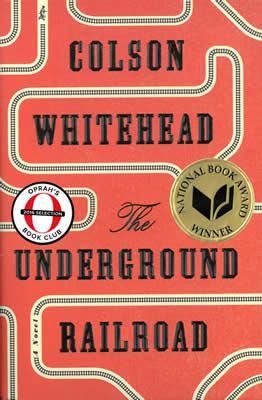 This was a difficult book to review, because it’s 1) about slavery, which is hard to talk about; and 2) it won the Pulitzer Prize. So I’m a bit intimidated, but I’ll give you my thoughts.
This was a difficult book to review, because it’s 1) about slavery, which is hard to talk about; and 2) it won the Pulitzer Prize. So I’m a bit intimidated, but I’ll give you my thoughts.
The novel begins on a slave plantation in Georgia, in the early 1800’s. Cora is a young woman whose mother and grandmother worked on the same plantation. She’s approached by Caesar, an educated slave who’s new to the plantation, about running away to the Underground Railroad. Cora initially says no – slaves who run away are inevitably captured and undergo horrific torture as a warning to the other slaves. Cora’s mother is the exception; she ran away not too long ago and was never found. After a violent incident on the plantation, Cora decides to try Caesar’s plan.
Whitehead uses this plot as a way to explore the different ways States mistreated and exploited the slaves. He re-imagines the Underground Railroad in a literal sense: the Railroad is a set of underground tunnels and tracks connecting states in the South to the states in the North. Riders on the train have no control over where they go or when they get off, and it’s a harrowing ride, but they will be helped along the way.
The book takes place in a number of states, and each state has a different approach to the slavery “problem”. Georgia needs its slaves for plantation labor, but South Carolina gives black people freedom, housing, and places to work, but it secretly conducts medical experiments and sterilizes the population without their consent. North Carolina decides to kill off all of the blacks because they’re concerned that whites are outnumbered and vulnerable to an uprising (they will use white immigrants as cheap labor instead, but those immigrants get to pay off their debt and become citizens).
If you want to see what this nation is all about, you have to ride the rails. Look outside as you speed through, and you’ll find the true face of America. It was a joke, then, from the start. There was only darkness outside the windows on her journeys, and only ever would be darkness.
Cora’s story is an engaging one, and her struggle feels very real. She’s written as an observer of the many wrongs that blacks endured but she’s also an interesting, multi-dimensional character. Some reviewers have commented on the pacing of the novel, which at times lags because of lengthy descriptions of the Railroad or of the different places and their political situations. Still, I didn’t find any part of this book uninteresting, from the political and historical elements to Cora’s own struggle to forgive her mother for abandoning her.
I was struck by the hope in this book, but also the devastation that often follows. In each situation, Cora has something to cherish, whether it’s a book or a friend or even self-determination, and yet those things can be taken away in an instant when you have no rights.
Despite its difficult subject, I found the book very readable. The writing is visual and complex, and almost every line in this book is quotable. The only thing I will comment on is there’s a certain lack of emotion in the writing. For example, Cora’s relationship in the latter part of the book is nice but never feels real. She has an unemotional way of looking at the world, except for her strong feelings about her mother. Although a lack of emotion makes perfect sense in a world where your family and friends can be taken from you at any time. Still, while I was absorbed in this book, I didn’t truly feel caught up in Cora’s emotions.
I think, though, a more emotional book would have been much harder to read, considering what the characters go through. This is a book that really made me think, and for that reason it’s a book I recommend reading.

